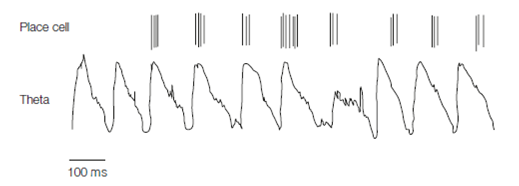Place cells
Evidence for the cognitive map hypothesis is the existence of place cells pyramidal cells in the hippocampus which fire when a rat is in a particular position in its environment. In a typical experiment rats with electrodes chronically implanted in the hippocampus for extracellular recording are allowed to explore a plus-shaped maze. An animal’s learn the spatial relationships among the maze and visual cues in the surrounding laboratory so as to find a food reward located in one of the four arms of the maze. The location in the maze which causes the place cell to fire is the cell’s place field (analogous to the sensory field of sensory neurons) and the entire maze is encoded by an array of place cells.
Place cells fire at a higher frequency the faster the animal moves, so are encoding loco- motor cues, although place fields are influenced by sensory cues. The higher the firing frequency of a place cell, the smaller its place field. This sets an upper limit on distance coding of about 50 cm which is, locations and objects > 50 cm ahead will be indistinguishable in a rat’s cognitive map, but will be resolved as the animal moves forward. A place cell may have several place fields, each for a different environment. New place fields arise as an animal explores a novel environment and altering familiar surroundings disrupts preexisting place fields.
When rats explore a maze, the EEG shows a theta (q) rhythm with a frequency of 4–10 Hz which reflects periodic firing of all hippocampal neurons (including place cells) organized by GABAergic interneurons. During q discharge, place cells encoding new information about the environment are entrained by the q rhythm while all other pyramidal cells are silenced by inhibition from GABAergic interneurons. Thus, q activity ensures that only cells involved in learning a particular environment are active.

Figure: Hippocampal theta and place cell firing in CAI as a rat walks through a familiar environment. Note the theta phase precession.
The firing of hippocampal place cells describes a systematic phase relationship to the theta rhythm. Individual place cells fire when the animal enters a particular region in its environment but this firing is modulated at a slightly higher frequency than the theta rhythm. Hence, as the animal moves through the place field the place cell fires at a progressively earlier phase of the theta rhythm. This is called theta phase precession. It is an example of temporal coding and encodes the distance traveled. Theta phase precession is also modulated by sensory cues in the maze in the above Figure.